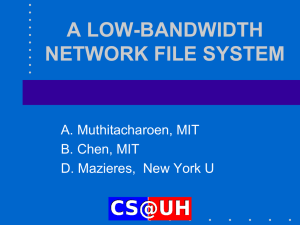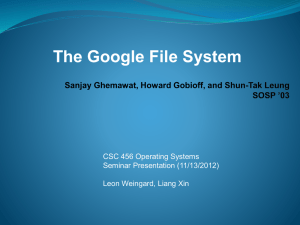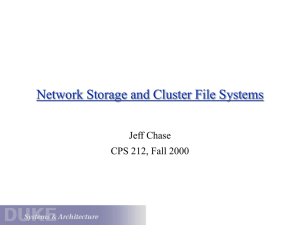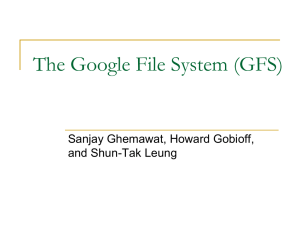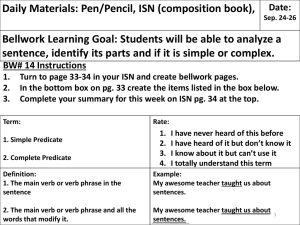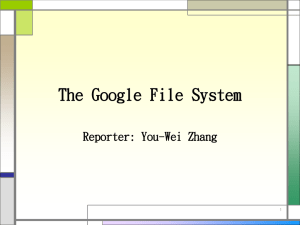NetworkFS-Andrea
advertisement
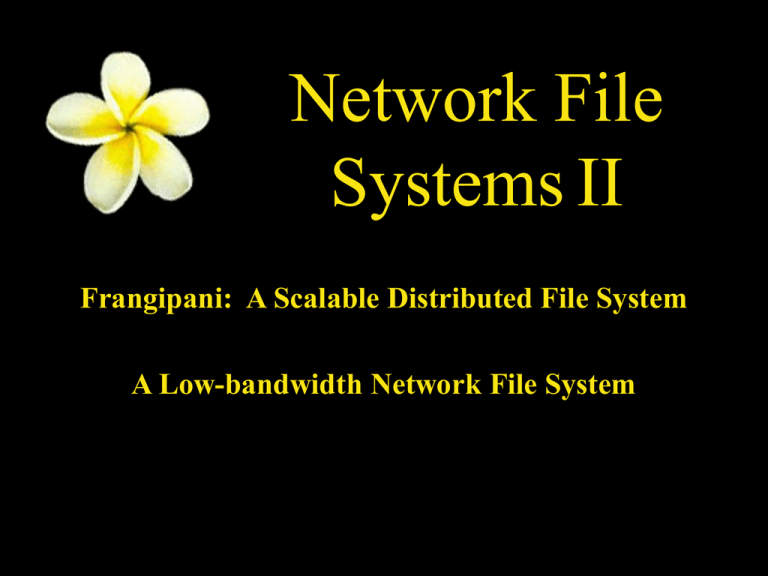
Network File Systems II Frangipani: A Scalable Distributed File System A Low-bandwidth Network File System Why Network File Systems? • Scalability – support more users and data – handle server failure gracefully • Improved accessibility – allow more users access – extend conditions under which access is feasible File System Requirements • Coherence: consistent, predictable file state • Efficiency: timely reads and writes • Security: provide access control • Recoverability: allow backup of file system Frangipani and LBFS • Frangipani file system: transparent scalability – easy administration at any scale – takes advantage of parallelism for good performance • Low Bandwidth File System (LBFS): reduce bandwidth to increase performance – takes advantage of duplicate file information – uses cacheing and compression to limit data volume Features of Frangipani • Petal: shared virtual disk • Frangipani: provides naming and structure for Petal • Lock system: distributed across servers • Leases: manage connections with lower state requirements • Backups: generated from Petal snapshots using the recovery process An Example Configuration The Petal Virtual Disk • Storage read/written in blocks • Sparse address space: 264 • Physical storage allotted only on write • Allows replication for high availability • Read-only snapshot feature Frangipani Disk Layout • Region 1: Disk configuration info (1 TB) • Region 2: Log space (1 TB), divided into 256 individual server logs • Region 3: Allocation bitmaps (3 TB), chunks owned by individual servers More Frangipani Disk Layout • Region 4: Inodes (1 TB), 231 512 byte inodes • Region 5: Small data blocks (128 TB) 235 blocks at 4 KB each • Region 6: Large data blocks, 224 1 TB blocks Frangipani Server Logs • Bounded: 128 KB, split across physical disks • Circular buffer scheme: 25% reclaimed when full • Uses sequence numbers to mark wrap point • 1000 to 1600 operations can be held in the log (entry size 80 to 128 bytes) Server Logging • Write-ahead redo policy • File metadata and physical file dated updated on disk after log write • Unix daemon handles disk writes every 30 seconds Lock Service • Many reader/single writer “sticky” locks • Asynchronous communication • Lamport’s Paxos algorithm replicates infrequently-changed data • Heartbeat messages determine liveness Locking: Avoiding Contention • Single lockable data structure per disk sector eliminates false sharing • Each file, directory, or symlink and its inode treated as a single lockable segment • Lock algorithm for aquiring multiple locks to avoid deadlock Crash Recovery • Detection of server crash based on lapsed leases, no network response – Recovery daemon given now owns log and locks – Metadata sequence nums prevent update replay No high-level semantic guarantee to users! Petal snapshot can be used for entire system recovery Performance Benchmarks Connectathon Benchmark AdvFS Raw AdvFS NVR Frang. Raw Frang. NVR s tatfs s ym li nk/re adl ink l ink/re name readdir read De s cription write chmod/s tat ge twd/s tat rm cre ate 0 0.5 1 1.5 2 Se conds 2.5 3 3.5 Frangipani: Conclusions • Frangipani meets the goals set for it: – coherent access – easy administration – scalable performance (limit is network itself) – good failure recovery Testing on a larger scale will be the true test of Frangipani Introduction to LBFS • Designed for efficient remote file access over low bandwidth networks – Exploits similarities between files and file versions – Client maintains a large cache of working files – Compression further reduces data volume – Uses NFS protocol for access control and access to existing file systems Why Do We Need LBFS? • Typical network file systems designed for 10 Mbit/sec or better bandwidth • Problems using FS over WAN: – – – – interactive programs that freeze batch commands that run several times slower less agressive applications are starved some applictions may not run at all! Why LBS (contined) • Downloading and editing files locally can lead to version conflicts • Upstream bandwidth is still limited with broadband LBFS eliminates these problems while still preserving consistency LBFS File Chunk Scheme In order to exploit commonality, files need to be broken into chunks • Server and client keep index of hashed chunks – Server index has chunk hashes for entire FS – Client index has chunk hashes for working files Chunk Creation Algorithm • Need to handle shifting offsets while keeping the chunk index managable – Examine every overlapping 48 byte region of the file – With probability 2-13, consider a region to be a breakpoint, or file chunk end marker Rabin Fingerprints • Rabin fingerprints help find breakpoints – Polynomial representation of data modulo an irreducible polynomial – When the low 13 bits of a region’s fingerprint equals a certain number, then it is selected – Given random data, the expected chunk size is 213 = 8192 = 8 KB + 48 byte breakpoint File Revisions With Breakpoints a. Original file b. Text Insertion c. Insert that includes breakpoint d. Elimination of a breakpoint Breakpoint Pathological Cases Data is usually not random! Worst case scenarios: – All 48 byte regions are breakpoints: the chunk index same size as file – No 48 byte regions are breakpoints: large chunks take extra time and memory for RPC Solution: define bounds: – min chunk size = 2 KB – max chunk size = 64 KB The Chunk Database • Each chunk indexed by the first 64 bits of its SHA-1 hash • Keys index <file, offset, count> tuples: must update when chunk changes • LBFS always recomputes hash value before use – hash collisions are detected – penalty of bad DB data only performance hit Benefits Provided by NFS 3 • NFS 3 IDs files by opaque handles that persist through file renaming • Handles access control for LBFS • Allows LBFS to use NFS protocol to access existing file systems • Disadvantage: i-number not changed when file is overwritten, so extra copy required LBFS Protocol Enhancements • Leases save permissions checks and data validation for recentlyaccessed files • Uses RPC, but with agressive pipelining • Gzip compression Maintaining File Consistency • Close-to-open consistency • Client needs whole-file cache • Multiple processes on a single client are allowed write access to same file simultaneously – LBFS writes back to file system on each close – Last close overwrites previous changes Profile of a Read Request Profile of a Write Request Security: One Concern • It is possible, through a systematic use of the CONDWRITE RPC call, to determine whether a particular hashed chunk exists in the file system: given away by response time variations LBFS Server Implementation • LBFS can run on top of another FS – server pretends to be an NFS client • Server creates a .lbfs.trash dir at root of every exported system – stores temp files indefinitely and garbage collect a random file when full LBFS Client Implementation • Client uses xfs device driver – passes messages through device node in /dev – xfs tells LBFS when to transfer file contents to/from server – LBFS fetches files to client cache, notifies xfs driver of bindings between cache contents and open files LBFS Performance Testing LBFS consumed far less bandwidth and allowed better application performance under test conditions – Workloads tested were typical applications of MSWord, gcc, and ed – CIFS, NFS, and AFS were tested (based on workload) for comparison – Also tested a “Leases and Gzip” only version LBFS: Conclusions • In low-bandwidth networks, LBFS outperforms the traditional file systems tested – similar consistency guarantees – implemented as transparent layer on top of an existing file system – public key cryptography provides security – client cacheing distributes load and reduces network dependency Last Word: Frangipani & LBFS • Both Frangipani and LBFS meet file system and distributed system requirements, but targeted different problems: – Frangipani achieved transparent scalability without performance loss – LBFS achieved feasible performance over WANs as a transparent add-on to a traditional FS using improved protocols and load sharing
